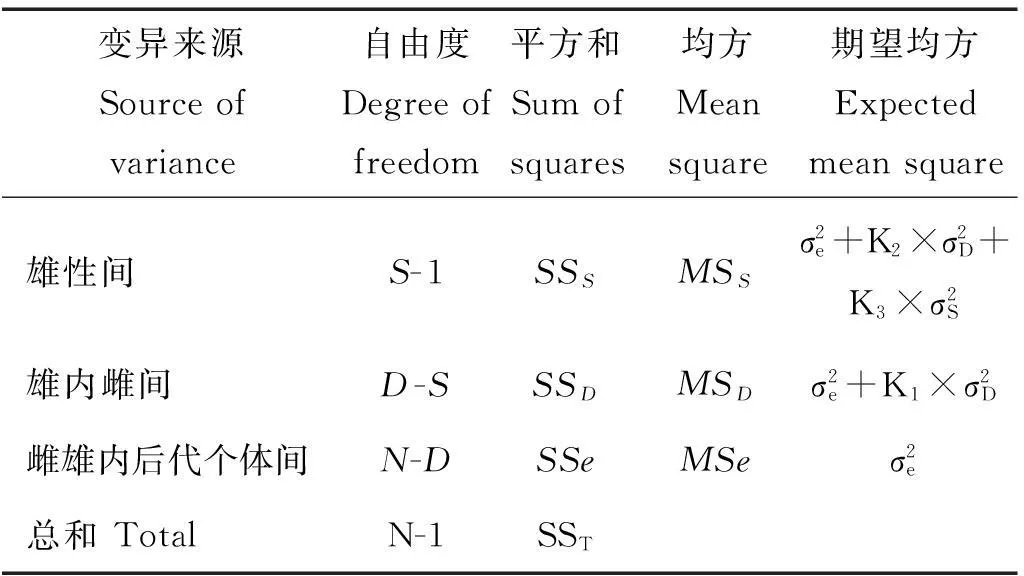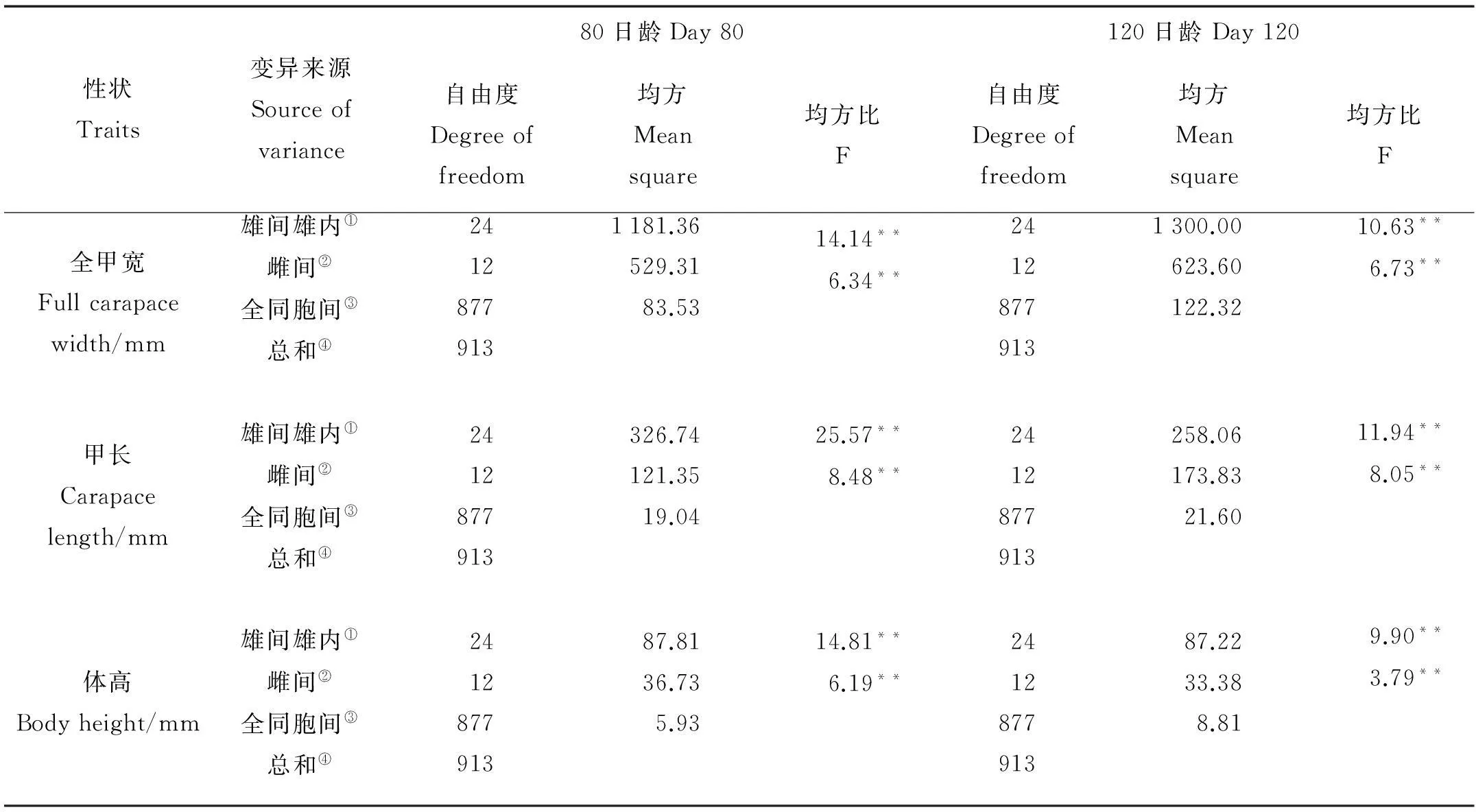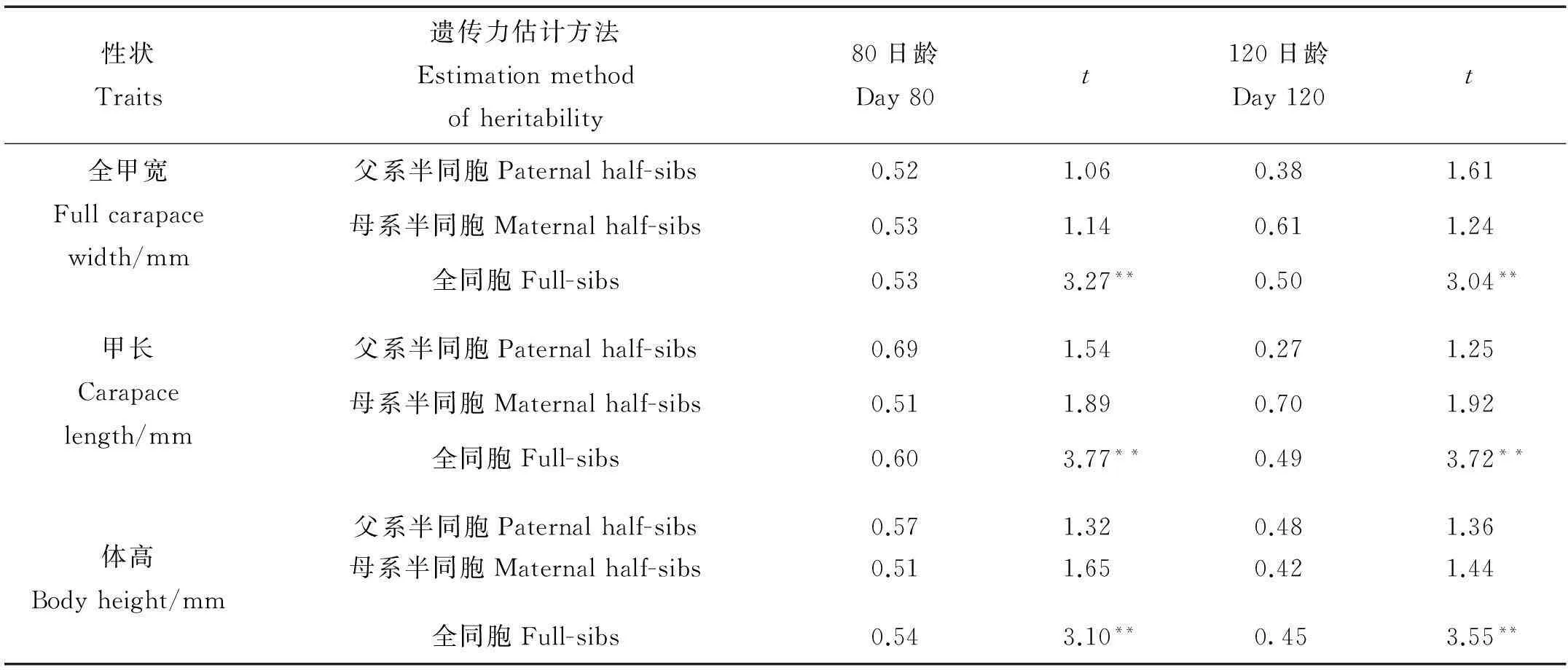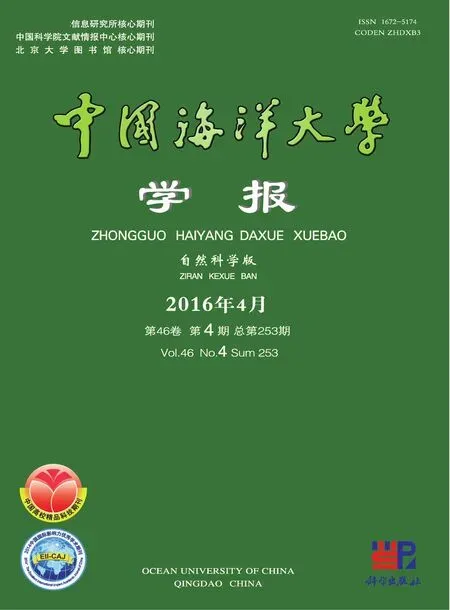三疣梭子蟹生长性状的遗传力评估*
2016-05-12高保全王清印
高保全, 刘 萍, 李 健, 王清印
(1.中国海洋大学,山东 青岛 266003; 2.中国水产科学研究院黄海水产研究所,山东 青岛266071)
三疣梭子蟹生长性状的遗传力评估*
高保全1,2, 刘萍2**, 李健2, 王清印1,2
(1.中国海洋大学,山东 青岛 266003; 2.中国水产科学研究院黄海水产研究所,山东 青岛266071)
摘要:准确可靠的遗传力是育种实践的前提,本研究采用不平衡巢式设计和室内定向交尾技术完成亲蟹交配,交配模式为1个雄性三疣梭子蟹配3个雌性三疣梭子蟹,建立100组上述交配组合;经过交尾、越冬,次年春天成功构建了37个三疣梭子蟹全同胞家系,其中13个半同胞家系;80和120日龄时每个家系随机选取30个左右个体,测量其全甲宽、甲长、体高3个生长性状。通过SPSS 11.5一般线性模型(GL.M),计算表型变量的方差组分,评估全甲宽、甲长、体高等重要经济性状的遗传力。结果表明,三疣梭子蟹80日龄3项生长性状总平均值分别为(77.99±11.42)、(35.90±5.84)、(20.13±7.77)mm,80日龄遗传力估计值为0.51~0.69;120日龄3项生长性状总平均值分别为(122.73±12.80)、55.(13±5.39)、(29.99±3.34)mm,120日龄遗传力估计值在0.27~0.70之间。通过t检验发现只有基于全同胞方差组分估计的遗传力达到极显著水平,而基于母系半同胞、父系半同胞方差组分估计的遗传力均未达到显著水平。因此三疣梭子蟹2个发育阶段狭义遗传力的无偏估计值为全同胞方差组分估计的遗传力,估计值分别为0.53~0.60和0.45~0.50。研究结果表明三疣梭子蟹3项重要经济性状属于高度遗传力,说明对其选择具有较大的潜力。
关键词:三疣梭子蟹;经济性状;遗传力
引用格式:高保全, 刘萍, 李健, 等. 三疣梭子蟹生长性状的遗传力评估 [J]. 中国海洋大学学报(自然科学版), 2016, 46(4): 56-62.
GAO Bao-Quan, LIU Ping, LI Jian, et al. Estimates for the heritability of economically important growth-traits inPortunustrituberculatus[J]. Periodical of Ocean University of China, 2016, 46(4): 56-62.
三疣梭子蟹(Portunustrituberculatus)味道鲜美、营养丰富,深受广大人民喜爱,另外养殖周期短、养殖工艺相对简单,已成为中国重要的海水养殖对象[1]。2006年中国三疣梭子蟹养殖面积达63.45万亩,但近年来由于国家工业园区和海参养殖业的蓬勃发展,三疣梭子蟹养殖面积逐年萎缩,2010年中国三疣梭子蟹养殖面积仅为44.85万亩[2-3],减少近30%,养殖产量也有所下滑,且萎缩趋势还在延续。为改善这种颓势,培育生长速度快、抗逆能力强的三疣梭子蟹新品种显得非常必要。
国外有关三疣梭子蟹的研究报道主要集中在日本和韩国,研究内容多为苗种培育、增殖放流、个体标记及分子生物学技术等。中国科学工作者对三疣梭子蟹的研究,主要集中在生理生态、营养饲料、疾病防治、基础生物学、人工苗种培育及养殖等方面[4-15]。有关三疣梭子蟹遗传参数评估方面的研究主要有如下几方面。高保全等[16]研究发现三疣梭子蟹形态性状与体重的相关系数均达到极显著水平(P<0.01);甲长、第二侧齿间距、全甲宽、体高、第一侧齿间距、大螯不动指长对体重的通径系数达到显著水平。刘磊等[17]研究发现三疣梭子蟹生长性状相关系数0.759~0.972,遗传相关系数0.170~0.975,表型相关和遗传相关都呈极显著水平(P<0.01)。王春琳等[18]研究发现三疣梭子蟹抗病候选群F2代、普通养殖群(RS)的头胸甲宽、头胸甲长、螯足长、游泳足长、第一步足长、第二步足长、第三步足长、两侧额齿问距、中额齿间距、下额齿间距等10个参数均与体质量显著相关。国际上水产动物遗传力的研究,与畜牧相比,开始较晚,上世纪后期,才开始有相关报道。如贝类进行遗传力研究的物种主要包括:海湾扇贝(Argopectenirradiansconcentricus)[19]、马氏珠母贝(Pinctadafucatamartensi)[20]、太平洋牡蛎(Crassostreagigas)[21]、美洲牡蛎(Crassostreavirginica)[22];鱼类方面主要包括:虹鳟(Salmogairdneri)[23-25]、尼罗罗非鱼(Tilapianilotica)[26]、大西洋鲑(Salmosalar)[27-28]等。遗传力估计采用的方法多为同胞分析法,涉及的性状非常多,比如头胸甲长、腹节长、体长、体宽、体高、体质量、排幼量、抱卵量、孵化率、变态率、饵料转化率及抗病力等重要的经济性状。中国水产动物遗传力评估的研究虽然开展较晚,但是近年来进展较快。比如三角帆蚌(Hyriopsiscuming)[29]、虾夷扇贝(Patinopectenyessoensis)[30]、合浦珠母贝(Pinctadafucata)[31]、九孔鲍(Haliotisdiversicolor)[32]、刺参(ApostichopusjaponicusSelenka)[33]、凡纳滨对虾((Litopenaeusvannamei)[34]、中国对虾(Fenneropenaeuschinensis)[35-36]、牙鲆(Paralichthysolivaceus)[37]、海胆(Strongylocentrotusintermedius)[38]、三疣梭子蟹(P.trituberculatus)[39]等相关性状遗传力的估计。本实验建立家系材料,采用方差分析法估计三疣梭子蟹80日龄、120日龄全甲宽、甲长、体高遗传力,为育种提供理论基础。
1材料与方法
1.1 亲本材料
100只雄性亲本、300只雌性亲本,均取自育种群体;其中雄性亲本全甲宽(127.92±11.30)mm,甲长(60.03±6.84)mm,体高(32.81±3.89)mm,体质量(129.56±11.28)g;雌性亲本全甲宽(120.75±10.30)mm,甲长(54.85±5.81)mm,体高(29.24±2.84)mm,体质量(109.60±10.35)g。
1.2 方法
1.2.1 交尾方案8月下旬,挑选发育良好的雄蟹和雌蟹,其中雌蟹未完成生殖蜕壳,利用人工控制定向交尾技术完成交配,其中1♂和3♀为1组,单独放入1个水泥池中。 次年4月15日—4月25日,建立37个全同胞家系,13个半同胞家系,均在同一苗种繁育车间培育。
1.2.2 培育和养殖褶皱臂尾轮虫(Brachinonusplicatilis)为三疣梭子蟹幼体开口饵料,Ⅰ~Ⅳ期溞状幼体以褶皱臂尾轮虫、卤虫(BrineShrimp)幼体为主要饵料,大眼幼体、幼蟹以卤虫成体为主要饵料。培育至Ⅱ期幼蟹,转移室外池塘养殖。标准化养殖池塘:2 400 m2养殖池,用纱网分割,平均分为12个小格,每个家系放入1个小格,每个家系放1 500尾蟹苗。家系的幼体培育及成体养殖条件基本 一致。养殖前期,以添水为主,7月上旬前,使水深达1.5 m以上;养殖中期每3~5 d换水1次,每次换水量30%~40%;养殖后期减少换水量及换水频率;前期(II~IV期)以丰年虫成体为主,V期幼蟹以后,以小蓝蛤(俗称海沙子、小白蛤)和新鲜杂鱼为主,在II、III、IV期幼蟹阶段,投喂量可达体重50%~70%,V期以后日投喂量为体重的8%~15%。水质环境:盐度20~32,pH在7.8~8.6,透明度30~40 cm,溶解氧>4.5 mg/L,氨态氮<1.0 mg/L,硫化氢<0.01 mg/L。
1.2.3 数据测量80、120日龄时,进行生长性状测量,选取指标为全甲宽、甲长及体高。测量方法:自每个家系围格中随机捕获30个左右的样本,由同一实验人员用游标卡尺测量,精确到0.1 mm。
1.2.4 统计分析采用全同胞组内相关法进行遗传力评估,通过SPSS 软件的一般线性模型过程完成数据方差分析,结果见表1。
表1全同胞资料表型变量组成的方差分析
Table 1Analysis of variance for phenotypic variation

变异来源Sourceofvariance自由度Degreeoffreedom平方和Sumofsquares均方Meansquare期望均方Expectedmeansquare雄性间S-1SSSMSSσ2e+K2×σ2D+K3×σ2S雄内雌间D-SSSDMSDσ2e+K1×σ2D雌雄内后代个体间N-DSSeMSeσ2e总和TotalN-1SST

1.2.5 遗传力评估及t检验遗传力评估公式如下[40]:
父系半同胞

母系半同胞

全同胞

2结果与分析
2.1 生长性状
三疣梭子蟹80和120日龄各生长性状的平均数和标准差见表2。
2.2 生长性状的方差分析
80和120日龄结果见表3。结果显示,雄性亲本间和雄蟹内雌蟹间80和120日龄各生长性状的F检验P<0.01。80日龄和120日龄,雄性亲本和雌性亲本间的有效平均后代数目计算结果:K1=20.19,K2=24.58,K3=36.30。

表2 三疣梭子蟹80日龄和120日龄的生长性状

表3 三疣梭子蟹80日龄和120日龄表型变量组成的方差分析
注:**表示差异极显著。** Means that difference is very significant.
①Among sires; ②Darns among sires; ③Arnong full-sibs; ④Total
2.3 表型变量的原因方差组分
80、120日龄表型变量的原因方差组分结果见表4。
2.4 遗传力的估计
估计了三疣梭子蟹80日龄和120日龄生长性状的遗传力(见表5)。80日龄生长性状遗传力的估计值为0.51~0.69;120日龄生长性状遗传力的估计值为0.27~0.70。t检验结果为:只有基于全同胞方差组分估计的遗传力达到极显著水平,另外2种方法估计的遗传力未达到显著水平。
3讨论
遗传力是衡量遗传进展的主要标志,准确可靠的遗传力和个体育种值估计是育种实践的前提。实验材料相同的生长环境是获得精确遗传参数重要条件之一,但梭子蟹个体标记尚未完全解决,因此本研究采用围格进行家系标准化养殖,使其生长环境尽量一致。研究表明不同物种、不同性状遗传力差别较大,一般水产动物生长性状的遗传力为中高等水平。如黎火金等以33个全同胞家系材料,采用动物模型查明合浦珠母贝幼贝生长性状遗传力为0.200~0.204[31];蒋湘以32个全同胞家系为材料,采用REMAL方法得到其生长性状遗传力为0.13~0.18[32];王俊杰等以16个全同胞家系为材料,采用SPSS GLM模型得到虾夷扇贝体质量遗传力为0.219~0.617[30];王照旗以42个全同胞家系为材料,采用ASREML软件的约束极大似然法,查明三角帆蚌1龄阶段生长性状遗传力为0.24~0.31[29];Quinton等利用全同胞资料估计大西洋鲑收获时体重遗传力,结果为0.10~0.20[27];;Fishback等采用MtdfremL方法获得虹鳟体重及体长的遗传力,估计值为0.36~0.72[24];田永胜等以家系选育F3代家系为材料,采用最小范数二阶无偏估计法得到牙鲆生长性状广义遗传力为0.38~0.54,狭义遗传力为0.099~0.24[37]; Benzie等估计了斑节对虾42、70日龄全体长、体重的遗传力,得到母系半同胞遗传力为0.39,父系半同胞为0.10[41]; 徐如卫等以54个全同胞为材料,采用SPSS统一线性模型获得凡纳滨对虾生长性状遗传力为0.234~0.460[34];Argue等利用家系材料,评估凡纳滨对虾生长性状的遗传力,结果为0.84[42];田燚等利用混合家系材料进行中国对虾145日龄体重遗传力评估,遗传力估计值为0.14[34]。本研究发现三疣梭子蟹生长性状遗传力为0.45~0.60之间,为高度遗传力,与其他物种生长性状研究结论一致。

表4 表型变量的原因方差组分

表5 三疣梭子蟹80日龄和120日龄生长性状的遗传力及t检验
注:**表示差异极显著。** Means that difference is very significant.
影响估计值的因素有很多,如遗传结构、遗传背景、生长环境、样本数量、操作人员、采用的软件及方法等,均能引起评估结果有所不同。如徐如卫等[34]和Argue等[42]估计的凡纳滨对虾生长性状遗传力差别较大,前者为0.23~0.46,而后者为0.84;究其原因主要有以下4方面:1、实验材料遗传结构和遗传背景不同;2、样本数量不同,前者为54个全同胞家系,其中18个半同胞家系,后者为43个全同胞家系,其中10个半同胞家系;3、实验材料生长环境及生长周期不同;4、数据统计分析所用软件工具不同。本实验结果表明三疣梭子蟹全甲宽、甲长、体高属于高度遗传力,对其进行选育应具有较大的潜力,可采用群体选择或家系选择,研究结果为三疣梭子蟹育种方案的制定提供了理论支持。但由于全同胞组内相关法不能利用个体间的亲缘信息,无法剖分随机效应,其估计值一般偏高。精确可靠的遗传力是制订准确、完善的育种方案的必要条件。而完整的系谱记录,相同的养殖环境和足够大的样本含量是提高遗传力估计准确性的主要条件。因此下一步尚需通过以下措施更精确的估算三疣梭子蟹生长性状遗传力:(1)统计连续几代家系生长数据,且个体间系谱关系清晰;(2)增加全(半)同胞家系数量及每个家系测量的样本数;(3)研发个体识别标记,采取家系混养,剔除环境差异;(4)开发更科学的方差组分估计方法,进行数据分析。
参考文献:
[1]吴常文, 虞顺成, 吕永林. 梭子蟹渔业技术 [M]. 上海: 上海科学出版社, 1996, 28-31.
Wu C W, Yu S C, Lv Y L. Fisheries Technology ofPortunustrituberculatus[M]. Shanghai: Shanghai Science Express, 1996: 28-31.
[2]农业部渔业局. 2006年中国渔业统计年鉴 [M]. 北京: 中国农业出版社, 2007, 54.
Fishery Bureau, Ministry of Agriculture, China. China Fisheries Yearbook 2006 [M]. Beijing: Chinese Agriculture Express, 2007: 54.
[3]农业部渔业局. 2010年中国渔业统计年鉴 [M]. 北京: 中国农业出版社, 2011, 57.
Fishery Bureau, Ministry of Agriculture, China. China Fisheries Yearbook 2010 [M]. Beijing: Chinese Agriculture Express, 2011: 57.
[4]孙颖民, 宋志乐, 严瑞深. 三疣梭子蟹生长的初步研究[J]. 生态学报, 1984, 4(1): 57-64.
Sun Y M, S Z L,Yan R S. Preliminary study on the growth ofPortunustrituberculatus[J]. Acta Ecologica Sinica, 1984, 4(1): 57-64.
[5]孙颖民, 闫愚, 孙进杰. 三疣梭子蟹的幼体发育[J]. 水产学报, 1984, 8(3): 219-226.
Sun Y M, Yan Y, Sun J J. The larval development ofPortunustrituberculatus[J]. Journal of Fisheries of China, 1984, 8(3): 219-226.
[6]李太武. 三疣梭子蟹精子的发生及超微结构的研究[J]. 动物学报, 1995, 41(1): 41-47.
Li T W. On spermatogenesis and sperm ultrastructure of blue crabPortunustriuberbuculatus(Crustacea, Decapoda) [J]. Acta Zoologica Sinica, 1995, 41(1): 41-47.
[7]李太武. 三疣梭子蟹肝脏的结构研究[J]. 海洋与湖沼, 1996, 27(5): 471-477.
Li T W. Studies on structure of hepatopancreas inPortunustriuberbuculatus[J]. Oceanologia Et Limnologia Sinica, 1996, 27(5): 471-477.
[8]余红卫, 朱东发, 韩宝芹. 三疣梭子蟹不同组织同工酶的分析[J]. 动物学杂志, 2005, 40(1): 84-87.
Yu HW, Zhu DF, Han BQ. The Isozymes in Different Tissues ofPortunustriuberbuculatus[J]. Chinese Journal of Zoology, 2005,40(1): 84-87.
[9]宋海棠, 丁耀平, 许源剑. 浙江近海三疣梭子蟹洄游分布和群体组成特征[J]. 海洋通报, 1989, 8(1): 66-74.
Song H T, Ding Y P, Xu Y J. Migrationdistribution and Population composition ofPortunustrituberculatusin the Zhejiang offshore [J]. Marine Science Bulletin, 1989, 8(1): 66-74.
[10]朱冬发, 王春琳, 李志强, 等. 三疣梭子蟹核型分析[J]. 水产学报, 2005, 29(5): 649-653
Zhu D F, Wang C L, Li Z Q, et al. Karyotype analysis onPortunustrituberculatus[J]. Journal of Fisheries of China, 2005, 29(5): 649-653.
[11]高保全, 刘萍, 李健, 等. 三疣梭子蟹四个野生群体形态差异分析 [J]. 中国水产科学, 2007, 14(2): 215-220.
Gao B Q, Liu P, Li J, et al. Analysis of morphological variations among four wild populations ofPortunustrituberculatus[J]. Journal of Fishery Sciences of China, 2007, 14(2): 215-220.
[12]李晓萍, 刘萍, 李健, 等. 应用SSR分析5个三疣梭子蟹野生群体的遗传多样性[J]. 中国水产科学, 2011, 18(6): 1327-1334.
Li X P, Liu P, Li J, et al. Genetic diversity among five wild populations ofPortunustrituberculatus[J]. Journal of Fishery Sciences of China, 2011, 18(6): 1327-1334.
[13]樊祥国, 高保全, 刘萍, 等. 三疣梭子蟹4个野生群体遗传差异的同工酶分析[J]. 渔业科学进展, 2009, 30(4): 84-89.
Fan X G, Gao B Q, Liu P, et al. Genetic variation analysis of four wild populations ofPortunustrituberculatusby isozyme [J]. Progress in Fishery Sciences, 2009, 30(4): 84-89.
[14]戴艳菊, 刘萍, 高保全, 等. 三疣梭子蟹4个野生群体四个野生群体线粒体16S rRNA和COⅠ片断的比较分析[J]. 中国海洋大学学报(自然科学版), 2010: 40(3): 54-60.
Dai Y J, Liu P, Gao B Q, et al. Sequence analysis of mitochondrial 16S rRNA and COI gene fragments of four wild populations ofPortunustrituberculatus[J]. Periodical of Ocean University of China, 2010, 40(3): 54-60.
[15]高保全, 刘萍, 李健, 等. 三疣梭子蟹4个地理群体肥满度研究[J]. 中国海洋大学学报(自然科学版), 2012, 42(增刊): 51-53.
Gao B Q, Liu P, Li J, et al. A preliminary study on relative fatness ofPortunustrituberculatus[J]. Periodical of Ocean University of China, 2012, 42(sup): 51-53.
[16]高保全, 刘萍, 李健, 等. 三疣梭子蟹形态性状对体重影响的效果分析[J]. 海洋水产研究, 2008, 29(1): 44-50.
Gao B Q, Liu P, Li J, et al. The relationship between morphometric characters and body weight ofPortunustrituberculatus[J]. Marine Fisheries Research, 2008, 29(1): 44-50.
[17]刘磊, 李健, 高保全, 等. 三疣梭子蟹不同日龄生长性状相关性及对体重的影响[J]. 水产学报, 2009, 33(6): 964-971.
Liu L, Li J, Gao B Q, et al. Correlation of growth ofPortunustrituberculatusat the different ages and its impact on body weight [J]. Journal of Fisheries of China, 2009, 33(6): 965-972.
[18]王春琳, 吴丹华, 崔朝霞, 等. 三疣梭子蟹选育群F2S表型性状对体质量影响的效果分析 [J]. 海洋科学, 2013, 37(3): 100-108.
Wang C L, Wu D H, Cui Z X, et al.The effects of morphometric traits on body weight in F2 Population of Swimming crabPortunustrituberculatus[J]. Marine Sciences, 2013, 37(3): 100-108.
[19]Grenshaw J W, Heffernan P B,Walker R L. Heritability of growth rate in the southern Bay scallop,Argopectenirradiansconcentricus[J]. Journal of Shellfish Research, 1991, 10: 55-63.
[20]Wada K T.Genetic selection for shell traits in Japanese pear oyster,Pinctadafucatamartensi[J]. Aquaculture, 1986, 57: 171-176.
[21]Langdon C J, Jacobson D P, Evans F, et al..The molluscan broodstock program improving Pacific oyster broodstock through genetic selection [J]. Journal of Shellfish Research, 2000,19(1): 616.
[22]Davis C. Estimation of narrow-sense heritability for larval and juvenile growth traits in selected and unselected sub-lines of eastern oysters,Crassostreavirginica[J]. Journal of Shellfish Research, 2000, 19(1): 613.
[23]Aulstad D G, Gjedrem T, Skjervold. Genetic and environmental sources of variation in length and weight of rainbow trout (S.gairdneri) [J]. Fish Res Board Can,1972, 29: 237-341.
[24]Fishback A G, Danzmann R G, Ferguson M M, et al. Estimates of genetic parameters and genotype by environment interactions for growth traits of rainbow trout (Oncorhynchusmykiss)as inferred using molecular pedigrees [J]. Aquaculture, 2002, 206: 137-150.
[25]Gall G A E. Genetics of reproduction in domesticated rainbow trout [J]. J Fish Sci, 1975, 40: 19-28.
[26]Tave D, Smitherman R O. Predicted response to selection for early growth in Tilapia nilotica [J] .Trans Am Fish Soc, 1980,109: 439-455.
[27]Quinton C D, McMillan I, Glebe B D. Development of an Atlantic salmon(Salmosalar)genetic improvement program : Genetic parameter of harvest body weight and carcass quality traits estimated with animal models [J]. Aquaculture, 2005, 30: 211-217.
[28]Gunnes K, Gjedrem T. Selection experiments with salmon Ⅳ Growth of Atlantic salmon during two years in the sea [J]. Aquaculture, 1978, 5: 19-23.
[29]王照旗, 韩学凯, 白志毅, 等. 三角帆蚌紫色选育系1龄阶段内壳色及生长性状的遗传参数估计 [J]. 水产学报, 2014, 38(5): 644-650.
Wang Z Q, Han X K, Bai Z Y, et al. Estimates of genetic parameters for inner shell color and growth straits during one year old stage in the purple strain ofHyriopsiscumingiiusing microsatellite based parentage assignment [J]. Journal of Fisheries of China, 2014, 38(5): 644-650.
[30]王俊杰, 丁君, 常亚青, 等. 虾夷扇贝家系早中期生长性状比较与遗传参数估计 [J]. 水产学报, 2014, 38(9): 1318-1325.
Wang J J, Ding J, Chang Y Q, et al. The growth traits comparison and genetic parameter evaluation ofPatinopectenyessoensisin early and mid-stage [J]. Journal of Fisheries of China, 2014, 38(9): 1318-1325.
[31]黎火金, 刘宝锁, 罗会, 等. 合浦珠母贝幼贝生长性状的遗传参数估计 [J]. 中国水产科学, 2013, 20(6): 1182-1187.
Li H J, Liu B S, Luo H, et al. Estimates of genetic parameters for growth traits in juvenile pearl oysterPinctadafucata[J]. Journal of Fishery Sciences of China, 2013, 20(6): 1182-1187.
[32]蒋湘, 刘建勇, 赖志服. 九孔鲍(Haliotisdiversicolorsupertexta)耐低盐与生长性状的遗传参数评估 [J]. 海洋与湖沼, 2014, 45(3): 542-547.
Jiang X, Liu J Y, Lai Z F. Estimation of genetic parameter for low salinity tolerance and growth ofHaliotisDiversicolorSupertexta[J]. Oceanologia Et Limnologia Sinica, 2014, 45(3): 542-547.
[33]栾生, 孙慧玲, 孔杰. 剌参耳状幼体体长遗传力的估计 [J]. 中国水产科学, 2006, 13(3): 378-383.
Luan S, Sun H L, Kong J. Heritability of auricularia larval body length for sea cucumberApostichopusjeponicusSelenka [J]. Journal of Fishery Sciences of China, 2006, 13(3): 378-383.
[34]徐如卫, 钱昭英, 刘小林, 等. 凡纳滨对虾生长性状遗传参数的估计 [J]. 水产学报, 2013, 37(5): 672-678.
Xu R W, Qian Z Y, Liu X L, et al. Genetic parameter estimation for growth traits of Pacific white shrimp(Litopenaeusvannamei) [J]. Journal of Fisheries of China, 2013, 37(5): 672-678.
[35]田燚, 孔杰, 栾生, 等. 中国对虾生长性状遗传参数的估计 [J]. 海洋水产研究, 2008, 29(3): 1-6.
Tian Y, Kong J, Luan S, et al. Estimation of genetic parameters for growth traits of Chinese shrimpFenneropenaeuschinensis[J]. Marine Fisheries Research, 2008, 29(3): 1-6.
[36]黄付友, 何玉英, 李健, 等. “黄海1号”中国对虾体长遗传力的估计 [J]. 中国海洋大学学报(自然科学版), 2008, 38(2): 269-274.
Huang F Y, He Y Y, Li J, et al. Estimates for the Heritability of Body Length in ShrimpFenneropenaeuschinensisNamed “Huanghai No. 1” [J]. Periodical of Ocean University of China, 2008, 38(2): 269-274.
[37]田永胜, 陈红林, 齐文山, 等. 牙鲆选育F3代家系的建立及遗传效应分析 [J]. 海洋学报, 2015, 37(4): 40-51.
Tian Y S, Chen S L, Qi W S, et al. Establishment and estimated genetic effects ofParalichthysolivaceusF3 families [J]. Acta Oceanologica Sinica, 2015, 37(4): 40-51.
[38]刘小林. 常亚青, 相建海, 等. 虾夷马粪海胆早期生长发育的遗传力估计 [J]. 中国水产科学, 2003, 10(3): 206-211.
Liu X L, Chang Y Q, Xiang J H, et al. Heritability of juvenile growth for the sea urchinsStrongylocentrotusintermedius[J]. Journal of Fishery Sciences of China, 2003, 10(3): 206-211.
[39]高保全, 刘萍, 李健, 等. 三疣梭子蟹体重遗传力的估计 [J]. 海洋与湖沼, 2010, 41(3): 1-5.
Gao B Q, Liu P, Li J, et al. Heritability of body weight inPortunustrituberculatus[J]. Oceanologia Et Limnologia Sinica, 2010, 41(3): 1-5.
[40]盛志廉, 陈瑶生. 数量遗传学 [M]. 北京: 科学出版社, 2001: 60-74.
Shen Z L, Chen Y S. Quantitative Genetics [M]. Beinjing: Science Express, 2001: 60-74.
[41]Benzie J A H, Kenway M, Trott L. Estimates for the heritability of size in juvenilePenaeusmonodonprawns from half-sib matings [J]. Aquaculture, 1997, 152: 49-53.
[42]Argue B J, Arce S M, Lotz J M, et al. Selective breeding of Pacific white shrimp (Litopenaeusvannamei) for growth and resistance to Taura Syndrome Virus [J]. Aquaculture, 2002, 204: 447-460.
责任编辑高蓓
Estimates for the Heritability of Economically Important Growth-traits inPortunustrituberculatus
GAO Bao-Quan1,2, LIU Ping2*, LI Jian2, WANG Qing-Yin1,2
(1.Ocean University of China, Qingdao 266003, China;2.Yellow Sea Fisheries Research Institute,Chinese Academy of Fishery Sciences, Qingdao 266071, China)
Abstract:In China, farming of P. trituberculatus produces annual yields of up to 100 000 tons. With the expansion and intensification of P. trituberculatus, various questions such as diseases, bad quality of larvas and less natural resources, have occurred and been serious, causing economic losses. At last, these questions are resolved by provided excellent breeds provided by using the selecting breeding program. It is an important way of selecting breeding. We must know the heritability of the species, first. So, the heitability of economic traits in P. trituberculatus were estimated by means of intra group correlation of full-sibs on day 80 and 120. A total of 400 maturing crab were from the base populations, which was established at the Yellow Sea Fisheries Research Institute using four wild, geographically distinct, Chinese populations (Laizhou Gulf, Zhousha, Yalvjiangkou, and Haizhou Gulf). One hundred sires and three hundred dams were mated by 1♂×3♀, producing 37 full-sib families including 13 half-sib families. Families were hatched and reared separately under identical conditions until they reached the second crab stage. The outdoor pond was divided with netting into several equally-sized ponds and a total of 1 500 randomly-selected second-stage crabs from each family were moved to these separate small ponds. Families were reared and managed under identical conditions of feeding and drug administration. The full carapace width, carapace length, body height of about 30 individuals from each family were measured on 80 and 120 days. Causal components of phenotypic variance were calculated with the GLM procedure of SPSS software. The results showed full carapace width, carapace length, body height on day 80 and 120 of age were (77.99±11.42),(35.90±5.84),(20.13±7.77) and (122.73±12.80),(55.13±5.39),(29.99±3.34)mm respectively. The heritabilities of economic traits on day 80 and 120 of age 0.51~0.69 and 0.27~0.70 respectively. There were no significant difference in heritabilities estimates obtained from maternal and paternal genetic variance. But there was significant difference in heritability estimates obtained from components of variance of full-sibs within sires and dams. So it was concluded that heritability estimates (0.53~0.60, 0.45~0.50) obtained from components of variance of full-sibs within sires and dams were precise and unbiased for body weight on day 80 and 120, which suggested that the heritabilities of growth traits (e.g., full carapace width, carapace length, body height) were high.
Key words:Portunus trituberculatus;economic traits;heritability
DOI:10.16441/j.cnki.hdxb.20150246
中图法分类号:Q789
文献标志码:A
文章编号:1672-5176(2016)04-056-07
作者简介:高保全(1980-),男,博士生。E-mail:gaobq@ysfri.ac.cn.**通讯作者: E-mail:liuping@ysfri.ac.cn
收稿日期:2015-08-10 ;
修订日期:2015-10-28
*基金项目:国家高技术研究发展计划项目(2012AA10A409);山东省自然科学基金项目(ZR2013CQ046)资助
Supported by the Hi-Tech Research and Development Program of China(2012AA10A409); the Natural Science Foundation of Shandong Province (ZR2013CQ046)
